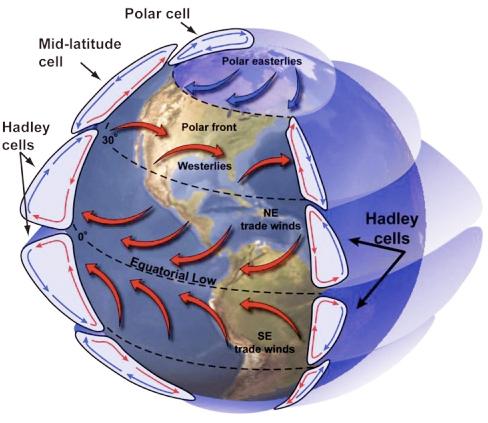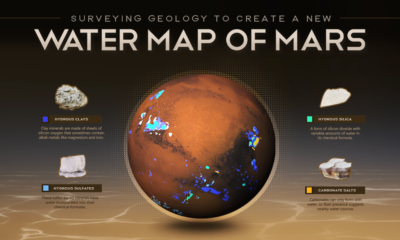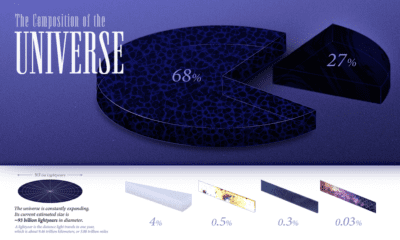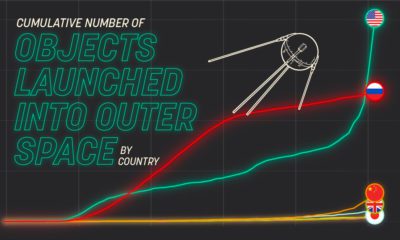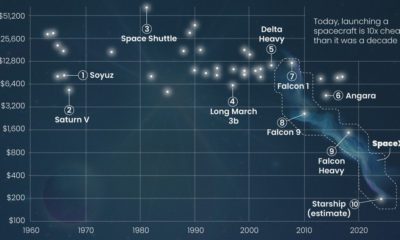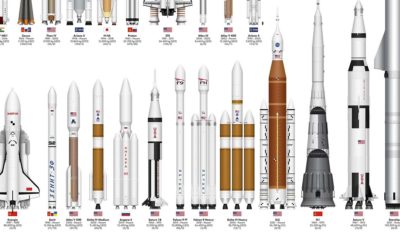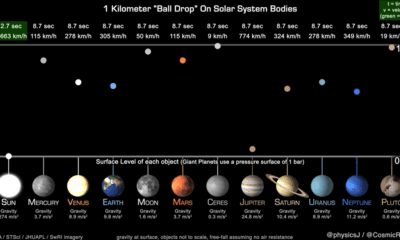Dr. James O’Donoghue, a planetary scientist at the Japanese space agency who has the creative ability to visually communicate space concepts like the speed of light and the vastness of the solar system, recently animated a video showing cross sections of different planets spinning at their own pace on one giant globe.
Cosmic Moves: The Rotation of the Planets
Each planet in the solar system moves to its own rhythm. The giant gas planets (Jupiter, Saturn, Uranus, and Neptune) spin more rapidly on their axes than the inner planets. The sun itself rotates slowly, only once a month. The planets all revolve around the sun in the same direction and in virtually the same plane. In addition, they all rotate in the same general direction, with the exceptions of Venus and Uranus. In the following animation, their respective rotation speeds are compared directly:
The most visually striking result of planetary spin is on Jupiter, which has the fastest rotation in the solar system. Massive storms of frozen ammonia grains whip across the surface of the gas giant at speeds of 340 miles (550 km) per hour. Interestingly, the patterns of each planet’s rotation can help in revealing whether they can support life or not.
Rotation and Habitability
As a fish in water is not aware it is wet, so it goes for humans and the atmosphere around us. New research reveals that the rate at which a planet spins is an essential component for supporting life. Not only does rotation control the length of day and night, bit it influences atmospheric wind patterns and the formation of clouds. The radiation the Earth receives from the Sun concentrates at the equator. The Sun heats the air in this region until it rises up through the atmosphere and moves towards the poles of the planet where it cools. This cool air falls through the atmosphere and flows back towards the equator. This process is known as a Hadley cell, and atmospheres can have multiple cells:
A planet with a quick rotation forms Hadley cells at low latitudes into different bands that encircle the planet. Clouds become prominent at tropical regions, which reflect a proportion of the light back into space. For a planet in a tighter orbit around its star, the radiation received from the star is much more extreme. This decreases the temperature difference between the equator and the poles, ultimately weakening Hadley cells. The result is fewer clouds in tropical regions available to protect the planet from intense heat, making the planet uninhabitable.
Slow Rotators: More Habitable
If a planet rotates slower, then the Hadley cells can expand to encircle the entire world. This is because the difference in temperature between the day and night side of the planet creates larger atmospheric circulation. Slow rotation makes days and nights longer, such that half of the planet bathes in light from the sun for an extended period of time. Simultaneously, the night side of the planet is able to cool down. This difference in temperature is large enough to cause the warm air from the day side to flow to the night side. This movement of air allows more clouds to form around a planet’s equator, protecting the surface from harmful space radiation, encouraging the possibility for the right conditions for life to form.
The Hunt for Habitable Planets
Measuring the rotation of planets is difficult with a telescope, so another good proxy would be to measure the level of heat emitted from a planet. An infrared telescope can measure the heat emitted from a planet’s clouds that formed over its equator. An unusually low temperature at the hottest location on the planet could indicate that the planet is potentially a habitable slow rotator. Of course, even if a planet’s rotation speed is just right, many other conditions come into play. The rotation of planets is just another piece in the puzzle in identifying the next Earth. on Even while political regimes across these countries have changed over time, they’ve largely followed a few different types of governance. Today, every country can ultimately be classified into just nine broad forms of government systems. This map by Truman Du uses information from Wikipedia to map the government systems that rule the world today.
Countries By Type of Government
It’s important to note that this map charts government systems according to each country’s legal framework. Many countries have constitutions stating their de jure or legally recognized system of government, but their de facto or realized form of governance may be quite different. Here is a list of the stated government system of UN member states and observers as of January 2023: Let’s take a closer look at some of these systems.
Monarchies
Brought back into the spotlight after the death of Queen Elizabeth II of England in September 2022, this form of government has a single ruler. They carry titles from king and queen to sultan or emperor, and their government systems can be further divided into three modern types: constitutional, semi-constitutional, and absolute. A constitutional monarchy sees the monarch act as head of state within the parameters of a constitution, giving them little to no real power. For example, King Charles III is the head of 15 Commonwealth nations including Canada and Australia. However, each has their own head of government. On the other hand, a semi-constitutional monarchy lets the monarch or ruling royal family retain substantial political powers, as is the case in Jordan and Morocco. However, their monarchs still rule the country according to a democratic constitution and in concert with other institutions. Finally, an absolute monarchy is most like the monarchies of old, where the ruler has full power over governance, with modern examples including Saudi Arabia and Vatican City.
Republics
Unlike monarchies, the people hold the power in a republic government system, directly electing representatives to form government. Again, there are multiple types of modern republic governments: presidential, semi-presidential, and parliamentary. The presidential republic could be considered a direct progression from monarchies. This system has a strong and independent chief executive with extensive powers when it comes to domestic affairs and foreign policy. An example of this is the United States, where the President is both the head of state and the head of government. In a semi-presidential republic, the president is the head of state and has some executive powers that are independent of the legislature. However, the prime minister (or chancellor or equivalent title) is the head of government, responsible to the legislature along with the cabinet. Russia is a classic example of this type of government. The last type of republic system is parliamentary. In this system, the president is a figurehead, while the head of government holds real power and is validated by and accountable to the parliament. This type of system can be seen in Germany, Italy, and India and is akin to constitutional monarchies. It’s also important to point out that some parliamentary republic systems operate slightly differently. For example in South Africa, the president is both the head of state and government, but is elected directly by the legislature. This leaves them (and their ministries) potentially subject to parliamentary confidence.
One-Party State
Many of the systems above involve multiple political parties vying to rule and govern their respective countries. In a one-party state, also called a single-party state or single-party system, only one political party has the right to form government. All other political parties are either outlawed or only allowed limited participation in elections. In this system, a country’s head of state and head of government can be executive or ceremonial but political power is constitutionally linked to a single political movement. China is the most well-known example of this government system, with the General Secretary of the Communist Party of China ruling as the de facto leader since 1989.
Provisional
The final form of government is a provisional government formed as an interim or transitional government. In this system, an emergency governmental body is created to manage political transitions after the collapse of a government, or when a new state is formed. Often these evolve into fully constitutionalized systems, but sometimes they hold power for longer than expected. Some examples of countries that are considered provisional include Libya, Burkina Faso, and Chad.
